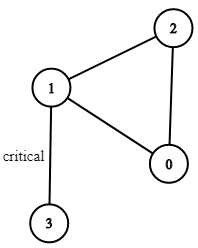Problem
There are n servers numbered from 0 to n-1 connected by undirected server-to-server connections forming a network where connections[i] = [a, b] represents a connection between servers a and b. Any server can reach any other server directly or indirectly through the network.
A critical connection is a connection that, if removed, will make some server unable to reach some other server.
Return all critical connections in the network in any order.
Example 1:

1 | Input: n = 4, connections = [[0,1],[1,2],[2,0],[1,3]] |
Constraints:
1 <= n <= 10^5n-1 <= connections.length <= 10^5connections[i][0] != connections[i][1]- There are no repeated connections.
Analysis
题目给出了一个图,要求我们找到所有的critical边,对critical的定义是一旦删除这条边,某些节点就会失去和其他节点的连接。先理解一下题意,这里涉及到了连通分量的问题。critical边实际的意义就是,一旦移除,就会多一个连通分量。
一下子好像无从下手,我们先来看什么是连通分量。以Example1为例,如果用1作为起点,它有两条路(注意这里的每一步,不能往前一个点走,但是可以走访问过的点):
- 往3走,然后就结束;
- 往0走,然后往2走,最后回到1,结束(或者是往2走,然后往0走,最后回到1,结束)。
对于1这个点来说,这两条路径是不一样的,第一条路实际上就是题目要找的critical边,而第二条路实际上是回环,并不存在critical边。所以我们的重点在于,如何去判断出第一条路径是有critical边,而第二条路径没有。
这里就要介绍一个图论中一个很重要的算法——Tarjan算法。这里我们不纠结于算法具体是什么或者完整实现是怎么样的,我们借助它的核心思路,然后直接来看应用到这道题上怎么做。其核心思想是基于深度优先解决图的连通性问题,这个点给了我很大的提示。我们要利用深度的信息去判断图的连通性,这个要怎么做呢?还是回到Example1中,还是用1作为起点,如果此时把1的深度定义为0,用DFS,那么它往后遍历每一个节点,深度就自增1。按照上面的两条路径:
- 节点3的深度是1,结束;
- 节点0的深度是1,节点2的深度是2,然后去到节点1的深度是0(这里不用更新为3,因为节点1的深度已经定义过了)。
根据这个深度我们能判断出来,如果dfs最后节点的深度大于当前的深度,则说明当前节点和最后的这个节点它们之间不能形成环,因此它们直接的connection就是critical的。这里需要注意dfs返回的结果是该节点往后的子孙节点中的最小深度。然后我们记录每一个节点的最小深度,如果已经访问过了,就不需要再做一遍dfs了。
Solution
无
Code
1 | class Solution { |
Summary
这道题目是难度很大的图论题目,据说是亚麻的面试题。在做这道题目前确实在这方面没什么经验,这道题目提供了一个解决类似问题的思路,利用dfs来计算子孙节点的深度,通过深度来判断连通性。这道题目的分享到这里,感谢你的支持!

